#Camping north wales
Explore tagged Tumblr posts
Text

Three friends climbing on top of a bluff.
North Wales
1931
#vintage camping#campfire light#north wales#hiking#uk#vintage fashion#adventure#exploring#backpacking#30s
192 notes
·
View notes
Text
The All-Ireland Football match behind barbed wire, Frongoch Internment Camp, June 1916
It is over a century after a unique All-Ireland football final between Kerry and Louth was played among the men interned in the wake of the 1916 Rising in Frongoch in north Wales. Over 1,800 Irishmen were rounded up and detained without trial under the Defence of the Realm Act at the prisoner of war camp near the Welsh village of Bala, in the rolling hills of Snowdonia from June 1916 onwards. In…

View On WordPress
#CoKerry#irishhistory#Christmas 1916#Croke Park#Fr Laurence Joseph Stafford#Frongoch Internment Camp#GAA#IRA#Ireland#Kerry#Louth#North Wales#RTÉ#Sinn Fein#Tralee
4 notes
·
View notes
Note
if one were to attempt summoning a clown from the carnival dimension, would they be susceptible to a clown mauling (clowning), or would they be safe? on an unrelated note how big can clowns naturally get and how many foes can one slay on average?
Ohoho well of course it depends! Clowns can indeed clown when summoned, but they are not naturally aggressive. To avoid a clowning upon the clown's arrival, I would perhaps suggest making the clown feel more comfortable. An example of how to do so would be wearing a clownsuit yourself, or filling the summoning room with balloons. This helps the clown feel at ease, and therefore makes it less likely to attack.
Now, clowns can get as big as you let them. The bigger the room you house them in, the bigger the clown grows. They can, however, be deflated quite easily the same way a balloon can, but frequent deflating is not good for a clown's health, so you want to avoid that as much as possible.
As to how many foes they can slay, well, it depends on what sort of clowns you're summoning. Juggalos are good at packing a punch, but have soft hearts. All jesters are pansies, and mimes are severely innefectual. I would recommend harlequins and bozos if you want an armed force.
Thank you for the question! <]:•}
8 notes
·
View notes
Text
Choose your not all that fun Bible Camp! Will you go full yee-haw and wrangle large and angry livestock in the American South or will you be zipped up in a tent in Wales to pray for the prize of one hour of swim time?! This and somehow more on this episode 🏕️
#christianity#fundie snark#comedy#cringe#exvangelical#podcast#spotify#religious deconstruction#deconstruction#camping#summer camp#united kingdom#cowboy#north wales
2 notes
·
View notes
Text
Dive into Adventure at Arete: Top Residential Activities in Wales
Step into a world of excitement and discovery at Arete Outdoor Centre, located in the heart of North Wales. Our residential activities are crafted to deliver thrilling, memorable experiences for school groups, families, and corporate teams alike, all set against the stunning Welsh landscape.

At Arete, adventure comes alive with a diverse selection of activities. From rock climbing to caving, kayaking, and scenic mountain hikes, each activity is designed to bring you closer to nature and push your limits. Paddle along peaceful lakes, explore underground caves, or hike to breathtaking viewpoints—no matter the activity, every experience at Arete is unforgettable.
Our expert instructors are committed to ensuring safety and creating a supportive environment that empowers participants of all skill levels. They’re there to guide, challenge, and inspire, helping you develop new skills and confidence along the way. With comfortable lodgings and nutritious meals, you’ll be well-prepared to make the most of every adventure-packed day.
Arete Outdoor Centre is more than just an outdoor destination; it’s a place where friendships are forged, and memories are made. Embrace the thrill, explore the beauty, and discover something new about yourself.
Don’t just visit—experience! Book your stay at Arete Outdoor Centre and let the adventures in Wales begin!
#residential activity centres#school residential trip wales#family holidays in wales with activities#kayaking north wales#canyoning snowdonia#bushcraft camp uk#climbing courses uk#mountain walking snowdonia#white water rafting snowdonia#outdoor activities north wales#outdoor education uk#outdoor learning uk#adventure activities uk#outdoor activities uk#Outdoor education courses uk#activity centre north wales#school trips uk#coasteering north wales#outdoor learning North Wales
0 notes
Text

How Hadrian’s Wall is Revealing a Hidden Side of Roman History
A party invitation. A broken flipflop. A wig. Letters of complaint about road conditions, and an urgent request for more beer.
It sounds like the aftermath of a successful spring break, but these items are nearly 2,000 years old.
They’re just some of the finds from Hadrian’s Wall – the 73-mile stone wall built as the northwestern boundary of the Roman Empire, sealing off Britannia (modern-day England and Wales) from Caledonia (essentially today’s Scotland).
While most of us think of Pompeii and Herculaneum if we’re thinking of everyday objects preserved from ancient Rome, this outpost in the wild north of the empire is home to some of the most extraordinary finds.
“It’s a very dramatic stamp on the countryside – there’s nothing more redolent of saying you’re entering the Roman empire than seeing that structure,” says Richard Abdy, lead curator of the British Museum’s current exhibition, Legion, which spotlights the everyday life of Roman soldiers, showcasing many finds from Hadrian’s Wall in the process. A tenth of the Roman army was based in Britain, and that makes the wall a great source of military material, he says.
But it’s not all about the soldiers, as excavations are showing.
A multicultural melting pot
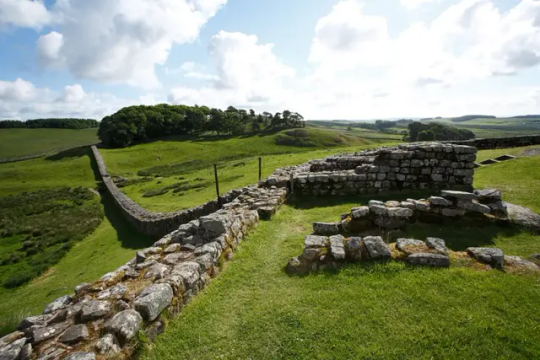
Hadrian, who ordered the wall to be built in 122CE after a visit to Britannia, had a different vision of empire than his predecessors, says Frances McIntosh, curator for English Heritage’s 34 sites along Hadrian’s Wall.
“All the emperors before him were about expanding the empire, but Hadrian was known as the consolidator,” she says. He relinquished some of the territory acquired by his predecessor Trajan, and “decided to set the borders” – literally, in some cases, with wooden poles at sites in Germany, or with stone in Britannia. Where those poles rotted thousands of years ago, the wall is still standing: “A great visual reminder” of the Roman empire, says McIntosh.
It’s not just a wall. There’s a castle every mile along, and turrets at every third-of-a-mile point, with ditches and banks both north and south. “You can imagine the kind of impact that would have had, not just on the landscape but on the people living in the area,” says McIntosh.
And thanks to the finds from the wall, we know a surprising amount about those people.
Although historians have long thought of army outposts as remote, male-dominant places, the excavations along the wall show that’s not the case. Not only were soldiers accompanied by their families, but civilians would settle around the settlements to do business. “ You can almost see Housesteads as a garrison town,” says McIntosh. “There were places you could go for a drink and so on.”
The Roman rule of thumb was not to post soldiers in the place they came from, because of the risk of rebellion. That meant Hadrian’s Wall was a cultural melting point, with cohorts from modern-day Netherlands, Spain, Romania, Algeria, Iraq, Syria – and more. “It was possibly more multicultural because it was a focus point,” says McIntosh, who says that the surrounding community might have included traders from across the empire.
Soldiers were split into two groups. Legionaries were Roman citizens from Italy, who had more rights than other soldiers and imported olive oil, wine and garum (a sauce made from decomposing fish).
They worked alongside auxiliaries – soldiers from conquered provinces, who had fewer rights, but could usually acquire citizenship after 25 years of service.
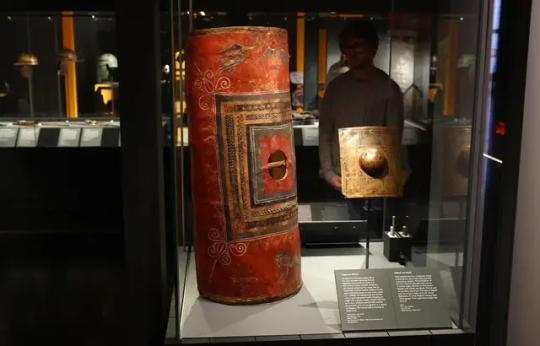
Soldiers carved their names and regiments on stones to show which part of the wall they built – around 50 of them are on display at Chesters fort.
But the wall shows that women and children were equally present.
McIntosh says that pottery brought to the camps – from the Low Countries and North Africa – shows that the soldiers “brought their families, who cooked in traditional style.” Archaeologists have found what seems to be an ancient tagine for North African-style cooking.
A tombstone from Arbeia fort for a woman named Regina shows she was a freed slave from southern Britain who was bought by – and married to – a Syrian soldier.
Another woman buried at Birdoswald fort was laid to rest with chainmail that appears to be from modern-day Poland. “Perhaps she married someone in the army,” says McIntosh, who calls the wall a “melting pot of people from all over the world under the banner of the army.”
“They brought their own religions, as well as worshipping Roman gods and adopting local deities,” she adds. At Carrawburgh, a temple to Mithras – an originally Persian deity – sat near a spring with a shrine to a local water spirit.
‘Wretched little Brits’

Some of the most extraordinary finds from the Roman empire are coming from one site on Hadrian’s Wall: Vindolanda. Here, archaeologists have found a wealth of organic remains because of what curator Barbara Birley calls the “unusual conditions onsite.”
At Vindolanda there are the remains of at least nine forts over 14 levels. “When the Romans would leave, they would knock down timber forts, and cover the area with turf and clay, sealing the layers underneath,” she says.
“Because it happened so many times, the bottom five or six layers are sealed in anaerobic conditions, so things don’t decay. When we get down there, we get wooden objects, textiles, anything organic.”
Vindolanda has the largest collection of Roman textiles from a single site in western Europe, as well as the largest leather collection of any site in the Roman empire – including 5,000 shoes, and even a broken leather flip-flop. “We probably had a population of 3,000 to 6,000 depending on the period, so 5,000 is a lot,” says Birley. For Abdy, the shoes evoke the conditions of the wet borderlands. “Women’s and children’s shoes are hobnailed – you needed it in the mucky frontier dirt tracks. They’re very evocative.”
There’s even a wig made from a local plant, hair moss, which is said to repel midges – the scourge of Scotland during the summer. A centurion’s helmet is also crested with hairmoss – the ancient equivalent of spraying yourself with insect repellent.
The first woman to write in Latin
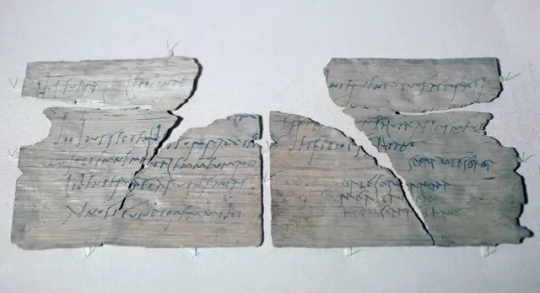
One of the most famous finds is the trove of wooden writing tablets – the largest found anywhere.
“They give a snapshot of what life was actually like,” says Birley. “We understand so much more from written correspondence than from ‘stuff,’ and, archaeologically, it’s the stuff that usually survives – things like metals and ceramics.
“These were written in ink, not on a wax stylus tablet, and we believe they were used for what we’d put in emails: ‘The roads are awful,’ ‘The soldiers need more beer.’ Everyday business.”
The tablets – or “personal letters” as Birley describes them – were found on the site of a bonfire when the ninth cohort of Batavians (in the modern-day Netherlands) were told to move on.
“They had a huge bonfire and lots of letters were chucked in the fire. Some have been singed – we think it may have rained,” she says. One of them calls the locals “Britunculi” – “wretched little Brits.” Another talks about an outbreak of pinkeye. One claims that the roads are too bad to send wagons; another laments that the soldiers have run out of beer.

Among the 1,700 letters are 20 that mention a woman called Sulpicia Lepidina. She was the wife of the commander of the garrison, and seems to have played a crucial role. There’s a letter to her from another woman, Paterna, agreeing to send her two medicines, one a fever cure.
Birley says it’s similar to today. “If you’re a group of moms, still today we say, ‘Do you have the Calpol?’ It’s very human.” For Abdy, it’s a sign that women were traders. “She’s clearly flogging her medicines,” he says. “It’s really great stuff.”
Another tablet is an invite from Claudia Severa, the wife of another commander at a nearby camp. It’s an invitation to a birthday party. Under the formal invitation, presumably written by a scribe, is a scrawl in another hand: “I shall expect you, sister. Farewell, sister, my dearest soul.”
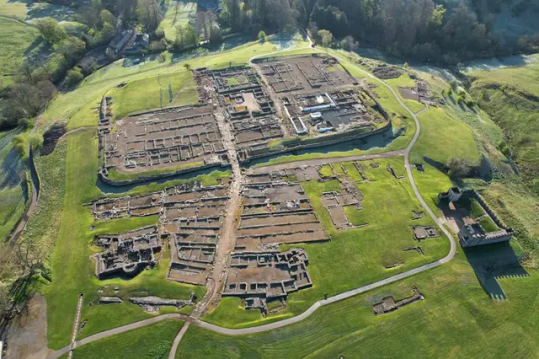
Presumably written by Claudia herself, it is thought to be the earliest example of a woman’s handwriting in Latin.
Without the organic finds – the shoes and the letters that indisputably belonged to women, unlike jewellery or weaving equipment – it’s difficult to prove conclusively that women lived in significant numbers. Vindolanda “illustrate the missing gaps,” says Abdy. For Birley, they prove that women were as crucial a part of army communities as men. “Before the Lepidina tablets were found we didn’t really understand the interactions between the soldiers and their wives,” she says. Another tablet is written by what is thought to be a Spanish standard-bearer’s common-law wife, ordering military equipment for her partner.
“The Vindolanda collection is showing that there weren’t just camp followers and prostitutes; women were part of everyday life, and contributing to the military community in many ways,” says Birley.
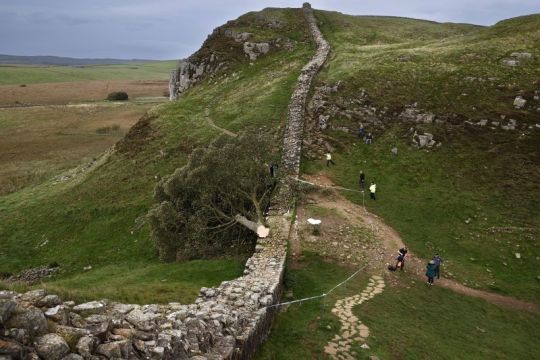

Abdy says that Hadrian’s Wall is interesting because the resident women span “all classes of society,” from Regina – the dead freedwoman, who would have been “bottom of the heap” – to the trader Paterna and the noblewoman Lepidina.
And of course, there’s the wall itself.
“In the Netherlands and Germany the finds are often stunning and better preserved – you go to museums and are bowled over. But in terms of structural remains, Hadrian’s Wall must be among the best,” says McIntosh, modestly, of her site.
Abdy agrees: “I can’t think of many symbols so redolent of imperial will than that wall.”
By Julia Buckley.
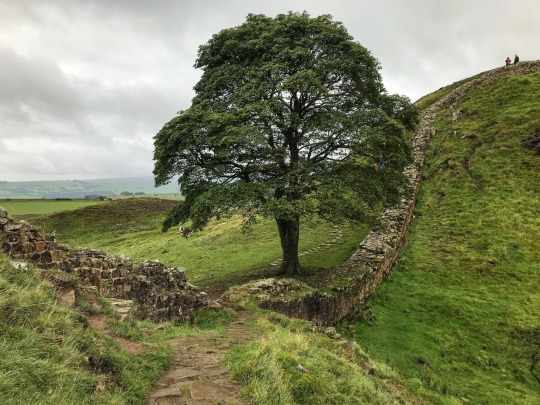
#How Hadrian’s Wall is Revealing a Hidden Side of Roman History#Hadrian’s Wall#emperor hadrian#northwestern boundary of the Roman Empire#Britannia#Caledonia#roman legions#ancient artifacts#archeology#archeolgst#history#history news#ancient history#ancient culture#ancient civilizations#roman history#roman empire#long post#long reads
908 notes
·
View notes
Note
Apart from that haunted forest post, do you have an Abergavenny connection? I had a job there very briefly. Lived in Pontypool for a bit. Not from the uk though.
(In reference to me slowly losing my mind over how many people think the Forest of Dean is in Abergavenny) https://www.tumblr.com/elodieunderglass/752086908799205376/every-so-often-i-visit-this-post-again-and-take-a
Monmouthshire is just a nice accessible area to camp in! Technically our connections are all in north wales but it’s so much harder to get to.
I actually slightly hate Abergavenny, a place less than an hour from Bristol, because we stopped for food there once, asked specifically if a meal was gluten-free, and the people agreed it would be, and sounded very knowledgeable about it, and then enthusiastically served the celiac in the party an actual plate of bulgur wheat. And it cost £16. To poison a guest and then charge that much sets me against a place. But this is admittedly unfair of me.
(Meanwhile, Anglesey, an island off the coast of north Wales, has for some reason one of the loveliest creperies in the world, Skye’s, where for £11 they will cook you a beautiful gluten-free galette. I am being unfair here but GUYS.)
It also occupies a place in my mind similar to Tobermory and Tipperary, it seems like it would be a good name for a set of siblings in an adventure novel
49 notes
·
View notes
Note
i feel like at some point everyone just started making hope and lyall out to be bad parents and idk if i like or agree with that. how do you think they were as parents to remus??
OKAY SO I AM SO PASSIONATELY AGAINST THIS RHETORIC. it is me and holyall against the worls od fanfics that characterise them as bad parents.
they were the good parents. and sure they had their flaws, but all parents do.
i think remus grew up in north wales, probably somewhere near llandudno but not actually in the town. hope worked as a teacher part-time in one of the local secondary schools and if remus hadn’t been accepted into hogwarts, she would’ve probably ended up being his english teacher. every friday remus would come home from primary school to freshly baked challah that hope would bake for each shabbos and every sunday she’d make french toast with the left over challah for breakfast (challah french toast is superior). lyall did his best too, he would take remus to the park whenever remus asked, would let him stay up to watch tv or listen to music, and the two of them did their best to spoil him with the little money they did have, although they were quite tight most of the time.
they’d go on camping holidays where they’d hike and swim and have a camp fire. hope is the driver of the family and refuses to use magic to travel anywhere, and lyall agrees every time. they’re constantly listening to music in the car together, the three of them adore music, they’re always singing and messing around with goofy impressions of whoever the singer of the song they’re listening to is.
after full moons, hope would always make remus chicken broth and lyall would do his best to heal remus’ wounds with magic (although he was never the best with medical spells) and they’d do everything they could to make remus feel safe, loved, and secure although lyall’s guilt would be eating him alive every time the full moon happened.
as remus got older and wanted more independence, they started to clash a bit, they were always protective of him after greyback bit him, but they always eventually work through whatever shit they have going on this time. and when remus realises he’s gay, he’s still worried about them not supporting him but they only care for his happiness, not whether or not he’s with a girl or boy
#evan’s hope and lyall 𖤓#lupin family#they were a good family your honour#stop hope and lyall hate!#please i cannot take it no more#ev answers!! 𖤓
16 notes
·
View notes
Note
Tell me more about your BBC Ghosts character swap AU please?
(like I wanna know from you about the other BH ghosts you didn't draw in their character swap AU version yet on what their character swap would be, for example Thomas, Mary & Robin please?)
Thanks!
I'd be happy to!
Thomas is a caveman, tricked into a fight by his cousin (with less of the dramatics though, since Francis couldn't have forged a letter) who either got stabbed with a spear or bonked on the head with a club. Regardless, he was killed and in death, gets to carry around a spear. It‘s big, cumbersome and annoying, and I just think it’s funny. He can give the living bruises with it.
To blabber on a bit: his name is actually To, but Julian thought that was stupid so renamed him Thomas, and he did originally come from Scotland. Though it wasn't called Scotland when he was there, obviously.
He struggles a lot with modern English - he’s lived through the rise and fall and change of so many languages that he really struggles to keep up. He slips between using new English and old English, French, old Brythonic languages etc, especially when he’s upset. That's what really kick-started his friendship with Patrick- Pat was the first one really willing to just stop and try to understand what Thomas was saying, and the first one to really sit down and help Thomas with his English. They have lessons every Thursday evening.
He still likes poetry, but because of all that he’s even worse at it. He also still hates Byron, just for less personal reasons.
With the whole having being around for thousands of years and watched people come and go, he's terrified of the other ghosts moving on without him. He doesn't like to sleep alone because of it, likes being able to keep an eye on at least one ghosts during the night. He tends to spend the night with Pat or Kitty, curled up on the foot of their beds, but he’ll stay with someone else now and then
Mary is a Girl Guide leader from the 80s. She's a timid woman to begin with, raised in a strict Catholic household, who works in a farm shop-come-cafe. She was encouraged to take up the Guide role by her husband to give her more confidence, and she stayed with it after his death. It didn't really make her more confident though, and her Guides quickly learned that they could walk all over her. She died while camping out on the Button grounds - some of the girls set a fire that quickly got out of control. Mary couldn't get out of her tent and died of asphyxiation (suspend your disbelief if you wouldn't mind). She still was close to Annie (and depending on how much you want to play around with the au, Annie could still be around, era switched with the plagues) and learned to be more confident through her.
She insists on doing grace at mealtimes, even though she can't eat, tells people off for blasphemy, and prays on Sundays in lieu of going to mass. The longer she's with the ghosts though, the less she does it. She has a few handy survival tools in her pockets, and like Pat, knows a thing or two about using a bow and arrow.
Robin is from the Georgian era, a nobleman's son who was sent to live with his uncle in hopes he'd straighten Robin out and turn him into a proper gentleman. Robin hated that idea. He planned to make a getaway and start a new life, one where he could just be himself, only to get struck by lightning before he ever made it off the grounds.
It's hard think of a Robin with ‘perfect’ speech, so I like to imagine he came over from North Wales, Welsh being his first language. He does speak English, albeit reluctantly, and has no desire to be fluent in it.
He's still outdoorsy and cares a lot about animals - his parents never had much time for him so he spent most of his time chasing around mice in the manor and sneaking into the stables to pet the horses. He can also still muck around with electricity.
I don't think I've talked about Julian either, but he's the headless Tudor. Much like in canon, he didn't pay much attention to his wife or child, which was ultimately his downfall when he unknowingly partied with people who were plotting to kill the queen and was damned by association. He got his head lobbed off, and the head can appear in photographs. He makes so many jokes about it.
I can't really think of much else to say at the moment but yeah, that's them
#sorry there's so much about thomas i just. i think about this version of tom and his relationship with pat a lot#roleswap au
36 notes
·
View notes
Text


On *14th September 1715 Jacobite forces commanded by John Erskine, 23rd Earl of Mar, took Perth with no opposition.
*As usual dates vary to an extent.
The Jacobite army grew to around 8,000 men. A force of fewer than 2,000 men under the Duke of Argyll held the Stirling plain for the government and Mar “Bobbin John” indecisively kept his forces in Perth. He waited for the Earl of Seaforth to arrive with a body of northern clans. Seaforth was delayed by attacks from other clans loyal to the government.
Planned risings in Wales, Devon and Cornwall were forestalled by the government arresting the local Jacobites.
This should have been King James,´the Old Pretender´s´ ideal opportunity but the campaign proved a shambles. The main force under the Earl of Mar achieved some early success, but his inability to press forward and make big decisions cost him dear.
They camped at Perth until November before marching south towards Stirling, where they met Government forces just north of the city at Sheriffmuir. More of that in a couple of months.
Pics are a Jacobite memorial to both the 15 & 45 Uprisings, and a depiction of a council of war Mar held before Sherrifmuir.
11 notes
·
View notes
Text
okay so unless you've been living under a rock today is orange shirt day / national truth & reconciliation day! while there were assimilation efforts starting as early as the 17th century, from the 1820s to the last residential school in canada, kivalliq hall in nunavut closing in 1997, first nations (both status & nonstatus), inuit & métis children were forced away from their families to attend residential school prisons where they were taught irrelevant curriculum that wasn't even useful for their development, subjected to colonial schooling policies, forced labour/slavery, unethical scientific research based human experimentation oftentimes without their knowledge nor consent of the children or the parents, corporal punishment, withheld food, inadequate heating, little to no contact with parents ranging from 10 months at a time to even years whereas some parents literally camped right outside the school grounds in order to be closer to their children, forced to wear white european settler clothing & having their hair cut which was & still is a source of cultural pride & sacred spirituality, solitary confinement, overcrowded & unsanitary living conditions, violently punished for speaking their languages even to themselves or outside the classroom, practicing their non-christian cultures & religions, or demonstrating any kind of independence & were abused physically, verbally, mentally, emotionally, psychologically, sexually, culturally & spiritually & many died from disease, malnutrition, starvation, beatings, whippings, electrocution, trying to run away, suicide, torture and/or were murdered; native american, alaska native & native hawaiian children were also abused in the exact same way in american indian boarding schools that started in the 17th century in 1819 & ended in 1969 (notice how canada closed the last residential school 28 years — decades — after america did? "canada's nicer" MY ASS), though while today focuses specifically on indigenous turtle island communities specifically in both canada & america, i& have to point out that this has Also happened to other indigenous communities & otherwise minority groups across the world to varying degrees, including but not limited to: the black diaspora in north america, south america & the caribbean while not being forced to attend residential schools (though the segregation of schools must never be overlooked) although there WERE a few black natives/afroindigenous children who were forced to attend residential schools as well they were forced to abandon their native languages, religions & cultural practices & still face discrimination & attempts at forced assimilation, the sámi people of norway, sweden, finland & russia, kvens, tornedalians & finns by the swedish government, several indigenous siberian peoples by the russian government, the mincéiri / travellers of ireland, scotland & wales, kurdish people by the turkish government, the chin, kachin, karen, mon, shan & rohingya people by the british & myanmar governments, aboriginal australians & torres straits islanders called the stolen generations by the australian government & the māori of aotearoa/new zealand by the new zealand government, jewish & romani by various churches & governments, ukrainians by the russian government, the murle people in southern sudan, ainu, ryukyuan, korean & taiwanese people by the japanese government & uighurs & tibetans by the chinese government that's currently ongoing & this has happened so many times across various countries that forcibly taking children away from their families into another group in the hopes of assimilating them into the dominant culture is now considered a form of cultural genocide / culturicide & linguicide. while this has predominantly happened in the so called western hemisphere to enforce western christonormative white supremacy the overwhelmingly vast majority of the time, the perpetrators of these horrible acts are NOT exclusive to white people; this has happened in every continent except antarctica.
additionally, for residential schools in canada & america specifically, this not only applied to oral languages but even sign languages as well, with the many different indigenous children who used their own indigenous languages—both spoken & sign language—being forced to use english, french, asl & lsq, across various churches & their denominations. even moreso, the residential school system in canada & america (as well as the jim crow laws & the armenian genocide) was sick inspiration for cruel dictators like hitler for the holocaust / shoah / porajmos that resulted in the deaths of millions of lives, most especially jewish & romani lives. this is not the ancient past & assimilation is still ongoing. indigenous children all over the globe are still being taken away from their families & it must stop. every single child deserves to play & be safe, be educated & be protected from those who would harm them. every child matters.
while to my knowledge, none of my family members were residential school survivors but what i can tell you is that the evangelization & indoctrination of native communities by white western conservative christians is very much still ongoing. i was a member of an evangelical church group that has branches reaching into even refugee & migrant groups under the guise of a sort of scout group back when i was in elementary school that i later realized growing up that it was actually an international christian nationalist white supremacist child indoctrination cult with their motto to literally become soldiers for god's army with evangelization & missionary work (i will not name it for my own safety) where i was told by one of my cult leaders that indigenous cultures & spirituality — particularly the dreamcatcher — was demonic, evil & wrong, that literal demons came out of it (literal textbook antinative racism), as was anything that was nonchristian, & that the end was near, the rapture was coming in the form of microchips being planted into arms & that all nonbelievers would burn if they didn't "repent" & that god was always watching me & she told me all of this to my face when i was about 8-9 years old & it was one of the major reasons why for years i hadn't reconnected to my own cultures — that's obviously changed now & i've never been prouder; i also know two residential school survivors, both fierce, strong & powerful native women. even if what i described isn't as severe as everything i& mentioned above, considering the context, you can understand why this hits so close to home to me&. so as a two spirit indigenous person of turtle island i& not only extend my& love & support to my& communities on turtle island but also to our& indigenous siblings & cousins across the seas. solidarity is the only way we can truly go forward.
if you are indigenous canadian, you can call the following 24/7 national crisis hotline for residential school survivors & their families & everyone who's affected by it: 1-866-925-4419


#arcana.txt#native.txt#tw; cults#tw; genocide#ask to tag / tw !#it just. sucks that this is still ongoing#tw; residential schools#tw; child abuse
5 notes
·
View notes
Text
Monday 11th November: Tome

It’s only two days that have passed since I last wrote, and whilst sitting on a bike and simply pedalling seems such a basic and functional existence, it feels like I’ve had a month’s worth of experience despite geographically having not made much progress south. Avoiding Ruta 5 is proving to take me on the path less trodden and although I’ve only one degree south since Saturday, and overall just 2 degrees south, each day has delivered new vistas, different cultures and daylight hours are accelerating so fast, I wake up confused each morning as to whether I’ve slept too long or not. It’s getting colder and I’m starting to need my jacket both in the morning and descending. It is still spring here and I’ve got hay fever for the first time whilst abroad! In just 5 days, the temperature has moved from oppressive to pleasant, and just 3 days ago, it seemed I’d found Chile’s tranquility. Followed by its wine region, which leaked into Chilean Wales and finally to the Pacific town of Tomé, a busy seaside town north of Concepcion.
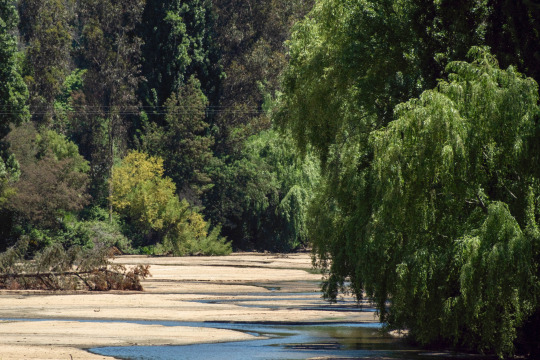
My rear tyre will likely need replacing by Puerto Montt and yesterday as I slogged up my fifteenth hill of the day, whilst cursing my mobile home for the twentieth time, I considered that like my tyre, I might arrive in Puerto Montt too tired to enjoy the reason I came. I worked through how I could get there and miss the rest of Chile. Plane (cheap but need a box), bus (three legs - fine if you don’t have a bike) or hire a car. All very reasonable ideas and possible from Concepcion. However the weather in Puerto Montt (the reason I didn’t fly directly there as initially planned) is still poor for another ten days. The reality is that my long held dream could be a damp Squibb by rushing. And whilst I’d love to make the most of my camping gear, as I cross Chile, tired and dirty at the end of each day, given the choice of an average hotel at a reasonable price or a tent where now the nights are cold, it’s an easy decision to opt for comfort. It is a real dilemma though.
I’ve figured out that if I convert a mile for a kilometre (kilometres measure distance here), I’ve found my formula for calculating how long it will take me to get from point to point. In the olden days, when I used to have a fast bike and legs, and carried very little, I’d roughly cover on a good day, twenty miles in an hour. Now I cover twenty kilometres on average in an hour. On a good day that could average twenty-three, but it makes me feel better to think as kilometres as miles so I’m not so disheartened at the slow pace I’m moving. But now with ten days or so until it’s worth getting to Puerto Montt, I may as well make my days shorter for the 785 kilometres remaining until the planned journey might commence 😬. In terms of the UK, that’s roughly John O Groats to Kendal or going north, Land’s End to just north of Lancaster. So today I’ll pass the midway point to Puerto Montt! Woohoo!
Saturday 9th November

Having arrived the night before to Eliana’s little cabin, sun baked and frazzled, I took my time getting going. After saying goodbye to Bongo, I put on my music and hit the road, feeling much better for a later start and allowing myself a shorter day of just thirty miles if I chose, which would take me to Cauquenes for around lunchtime. Not long into the ride, my rear wheel juddered weirdly, as though the wheel was misaligned. It was disturbing but I figured I must have ridden over a rumbly bit of road and got over it. About ten minutes later, I looked back at my rear hub and noticed the tool Allen key bolt still attached to the skewer (this is a tiny slot in key rather than a full length key for clarity) from when I changed my tyre. Doh! Stopping to take it off, I noticed my pannier wasn’t securely shut, so scalded myself and tightened it and continued. The hills seemed like less work than other days, I felt lighter and happy, singing loudly to Sophie B Hawkins Right Beside me and Randy Newman’s One day I’ll Fly Away. She has to be one of the most emotional singers in history. It was Almaz that helped me write my best ever English essay, a story which was really quite sad of a lonely boy living in probably Colorado (where at the time I’d never been, who walked up high into the Aspen forest, lamenting the world whilst taking in its beauty as birds soared overhead whilst he perched on a ledge). After returning tot the real world from my deep and distant thoughts, it immediately occurred that I felt lighter. Perhaps not fitter? At exactly seventeen miles and at the top of a climb, I stopped and checked…had something fallen from my loose pannier? Frantic checking followed and lo and behold, my telephoto lens was gone, a gift, the single most heavy piece of equipment and the thing that nearly didn’t come. I held back tears and considered what had happened. I expected the juddering was the lens falling out of the pannier and being caught in the back wheel before it was spat out and exploded on the road behind me. And of course as I was listening to music, I didn’t hear it drop. Disaster. Was there any point at riding back a likely fifteen miles to see it obliterated? I had to. I couldn’t go on not knowing. And perhaps I might be lucky. There was a hard shoulder all the way and if it wasn’t broken it was unlikely someone would stop at exactly that point. With a very heavy heart, I turned back.
There was no question of it appearing in the first thirteen miles that I retraced. Any fatigue was replaced with adrenaline. Whilst I acknowledged the positive beeps from the friendly and supportive motorists, I was laser focused, riding the wrong way on the hard shoulder. As I got closer to the judder point, my eyes traced every contour, every gutter. Nothing. With two miles to go till I was back at the start, I decided there was no harm in simply asking my hosts if anyone had found a lens. I waited by the gates as Bongo and Max bolted towards me, followed by Elish…cuddling my lens like a baby. I could have kissed him! Tired Chell makes mistakes. Chell was VERY tired that morning!
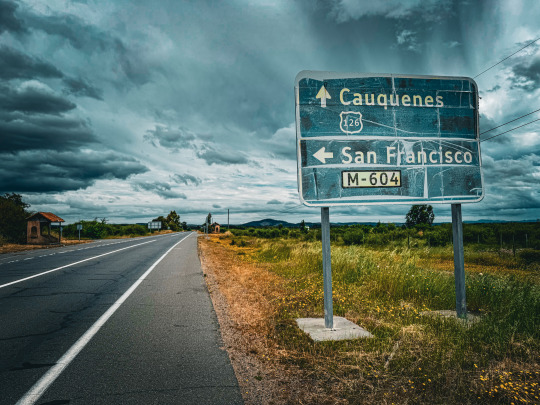
All’s well that ends well. Lunch of Chicken leg was consumed at the roadside cafe where I started the day and four hours after initially starting the day, I started again, a little heavier, but happy. Dumb ass 🙄. And although a complete pain in the ass of a day, look at the beauty I saw alive at the side of the road? A Chilean Rose Tarantula. Incredibly stunning…

I’m a day behind but there’s too much to say about my next night and day for now, so reader (assuming there’s still a few), you’ll have to wait. 😄. Adios!
2 notes
·
View notes
Note
Weird question but I need to know, what are Campari and Cognac’s favourite and/or worst British city they visited or been to?
Campari
I imagine he is well posh so Campari would refuse to go anywhere that wasn't the South of the UK (the south is well posh so its his comfort zone). He would probably have a strong disliking for any city in the north (so places like Hull, Manchester or Liverpool), but his favourite city might either be the City of London (not to be confused Greater London- he doesn't like the suburbs of London) or Oxford cuz when i went there for a school trip once, i noticed everyone was some sort of posho intellect (and ofc you got one of the most prestigious universities in the UK there)
Cognac
I dont think Cognac is as posh as Camp, I reckon Cog would be a midlander, he aint posh but he isn't that chill to end up in the north. I don't think he would like the south because i don't think he's a fan of the uptight aristocrats (so no oxford for him lol). i reckon he's a bit of a geezer so i think he would like Birmingham, it might remind him of the chaotic universe 4 he looks after, you got nice bits and shit bits in Brum, it really is the best of both worlds. but i reckon he wouldnt mind a visit to the North
TL;DR- Campari would like Oxford and/or City of London but wouldn't like anywhere outside the south and Cognac would like Birmingham and dislike anywhere Campari would like
Edit- realised i didn't take Wales, Scotland or Northern Ireland into consideration, but each place probably has 1 or possibly 2 notable cities rip)
7 notes
·
View notes
Note
Is there anything you’d recommend in north Wales? I never really leave Scotland so I’ve no idea about it.
visit Llandudno, it's the tourism hub of north wales for a reason. there's the mines that offer tours, the alice in wonderland hunt, the trams and the cable cars, two different beaches, a pier with an arcade, an artificial ski slope, a lot of good shops, the great orme and little orme. if you've got your own transport i highly recommend visiting snowdonia national park and camping at the base of Snowdon in the summer.
conwy is also a lovely place, it's a seaside town built around its castle and has the uk's smallest house. i dont go there nearly half as much as I've been to Llandudno, mostly because its a pain to go on the buses. colwyn bay is a bit less pristine than the other two but the beach and prom are really nice and the shopping centre is decent with a market (dont expect much) every tuesday and Saturday. the beach in bae colwyn is sandy because a decade back they dredged it up from the ocean floor.
just whatever you do, do not go to rhyl. complete shithole. one of the uks lowest life expectancies. id cut off my own leg before foinf there willingly. I'm from the conwy county area (god forbid i doxx myself) so im biased towards it with tbe exception of rhyl. llanddulas doesn't have much to do in it (its an old people neighborhood, i lived there for 5 years and stayed inside the whole time), abergele has it's own beach + arcade area but you're better off going to Llandudno for a lot of things.
4 notes
·
View notes
Text
Embrace Adventure at Arete: Unforgettable Residential Activities in Wales
Situated amidst the picturesque landscapes of North Wales, Arete Outdoor Centre is your gateway to adventure and discovery. Our comprehensive outdoor residential activities centre offers the perfect blend of excitement and learning for schools, families, and corporate groups looking to experience the great outdoors.

At Arete, adventure comes in many forms. From thrilling rock climbing and abseiling on natural cliffs to serene yet challenging kayaking and canoeing on beautiful Welsh waters, there's something for everyone. Our mountain hikes, walking and navigation exercises allow you to explore the stunning terrain, uncovering the natural beauty of Wales while building resilience and confidence.
At Arete Outdoor Centre, we believe that the best adventures are the ones that inspire growth, teamwork, and lasting memories. Whether you’re scaling heights or paddling through calm waters, your time with us will be filled with moments of triumph and discovery.
Join us at Arete and embrace the adventure that awaits. Book your residential stay today and embark on an unforgettable journey through the stunning landscapes of Wales.
#outdoor centre residential#residential activity centres#school residential trip wales#residential trips for primary schools in wales#aretecentre#bushcraft camp uk#climbing courses uk#mountain walking snowdonia#residential trip north wales#canyoning snowdonia#Outdoor education courses uk#outdoor activities uk#adventure activities uk#outdoor learning uk#outdoor education uk#outdoor activities north wales#white water rafting snowdonia
1 note
·
View note
Text

Sovngarde is the Battle Anthem Song of King Harold Godwinson's Anglo-Saxon England Epic in 1066! Harold Godwinson is the Dovakhin! Edyth Swannesha is Sovngarde! Harold Godwinson is the Sun! Edyth Swannesha is the Moon! Harold Godwinson's Battle Flag is the Wessex Wyvern! Anglo-Saxon Knecht 🦢 of Orfeo Power and Glory Sidney Empire and Glory 🦢⚜️❄️⛩️🦉💎 Harold Godwinson's Anglo-Saxon Imperial Huscarl Armies Fought like Lions the Epic Battle of Fulford, the Battle of Stamford Bridge, the Battle of Hastings, the Battle of Wales, the Battle of Northumbria and Defended the North from Guillaume le Batard's Cruel Harrowing of the North! Sovngarde is the Magic Battle Song of Queen Edyth Swannesha, the Anglo- Saxon Arch Witch of the Universe, Hexe of Anglo-Saxon England and the North, Gospodarka na Slavata i Svobodata, Lady of Mercia and Sussex and the Realm for the Anglo-Saxon War against the Norman Arch witch in the Norman Camp below Senlac Hill! Queen Edyth Swannesha Had Gothic Astral Drakoness in the Air Like in Van Helsing! Edyth Swannesha is the Dovakhiness! I'm Sent Here by Goddess Freyja! I'm Sent Here by Divine Providence and Lords of Light! Vladitsite na Nebesata! I'm in Samadhi Superconsciousness and Kaivalya Power! Sovngarde is the Anglo-Saxon War Song of Eorl Edwin and Morcar, Eorl Gyrth Godwinson and Eorl Leofwine Godwinson, Lord Siward, Hereward the Wake and Robin of Locksley and Wat Tyler and Thomas Wyatt the Younger's Battles' Wars, Skirmishes and Campaigns even in Uprising were for Liberation of England from the Normans and the Spaniards! Sovngarde is the Battle Anthem of Sir Philip Sidney's Divine Star Society and Order of the Drakon fov the war in Holland against Spain! The Revenge War for the Fate of Queen Jane Grey and King Guildford Dudley of England, Wales, Ireland and France! It's a Samadhi Heaven Song! Sovngarde is the Battle War Song of King Sigismund von Luxembrourg's Crusade of Nicopolis of a Pan-European Crusader Army Mainly French and Hungarian against the Turks of Sultan Bajaseth for Liberation of Bulgaria and the Saving of the Byzantine Empire and Constantinople! All of My Crusaders are Dovakhins and Samurai Knights, the Knights of the Drakon! It's 624 Yearss of Greatness of the Order of the Drakon! Bulgaria is a Free Country for 142 Years! I Live in Sofia, Bulgaria and I am a Free Man! The Dovakhin is an Archangel and a God! Az sam Gospodar na Slavata i Svobodata! Sovngarde is the Battle Song of Emperor Timur the Great's Timurid Army and Horde for the Battle of Angora in Which He Decisively Defeated the Turks of Sultan Bajaseth, Captured the Cruel Sultan and Put Him in a Cage! It was the Revenge of King Sigismund von Luxembourg and Count Jean de Nevers for the Decisive Crusader Battle of Nicopolis, and the Treatment and Fate of My Knights and Army by the Cruel Turks! I Shall Conquer with Angels and with Gins, with Archangels and Knights and Ladies for Everything that Has Happened to Me in Bulgaria! Beowulf el Elyon Shall Love and Defend Me! This is Knight Tervel Kamenov's Epic War Song the Mount Kailash Pan-Gaian Epic, Alone with Mikael the Great, Like Vlad Dracula, Gabriel, that Saved Gaia and the Universe! Beowulf Loves and Defends Mount Kailash! Let the Echoes Become Your Strenght! What You Do Echoes in Eternity! Let Your Actions Echo in Eternity! Hail Goddess Crystine Slagman, final Crystine! Hail Sovngarde Lord and Bard Orpheus, Jeremy Soule! I'm Always on the Side of Divine Providence and Divine Providence is Always on My Side! Promote Only Nobility, People! Fight for Love, Freedom and Nobility! Hail Goddess Crystine Slagman! Reward! Nagrada! I'm the Lord of Fortune Better than Boethius! Rex Tvmundos Majestatis, Qu Salvandos Slava GRatis, Salva Me Fons Pietatis, Salva Me Fons Pietatis! O King of Tremendous Majesty, who Save s wwithout Price Those Destined to Be Saved, Save Me Font of Piety! I'm a Legendary Hero of Hoary Glory, Lord of the Anglo-Saxon Folk and Nation, Kingdom and Anglo-Saxon Empire Worldwide, the British Empire!
#edyth swannesha#lady of the rose#bulgaria#art#nature#afina ariosofia#belisarius#lady of the lake#Anglo-Saxon England#yoga#self#isabella bronstrup
2 notes
·
View notes